How to Talk Rum
How to Talk Rum
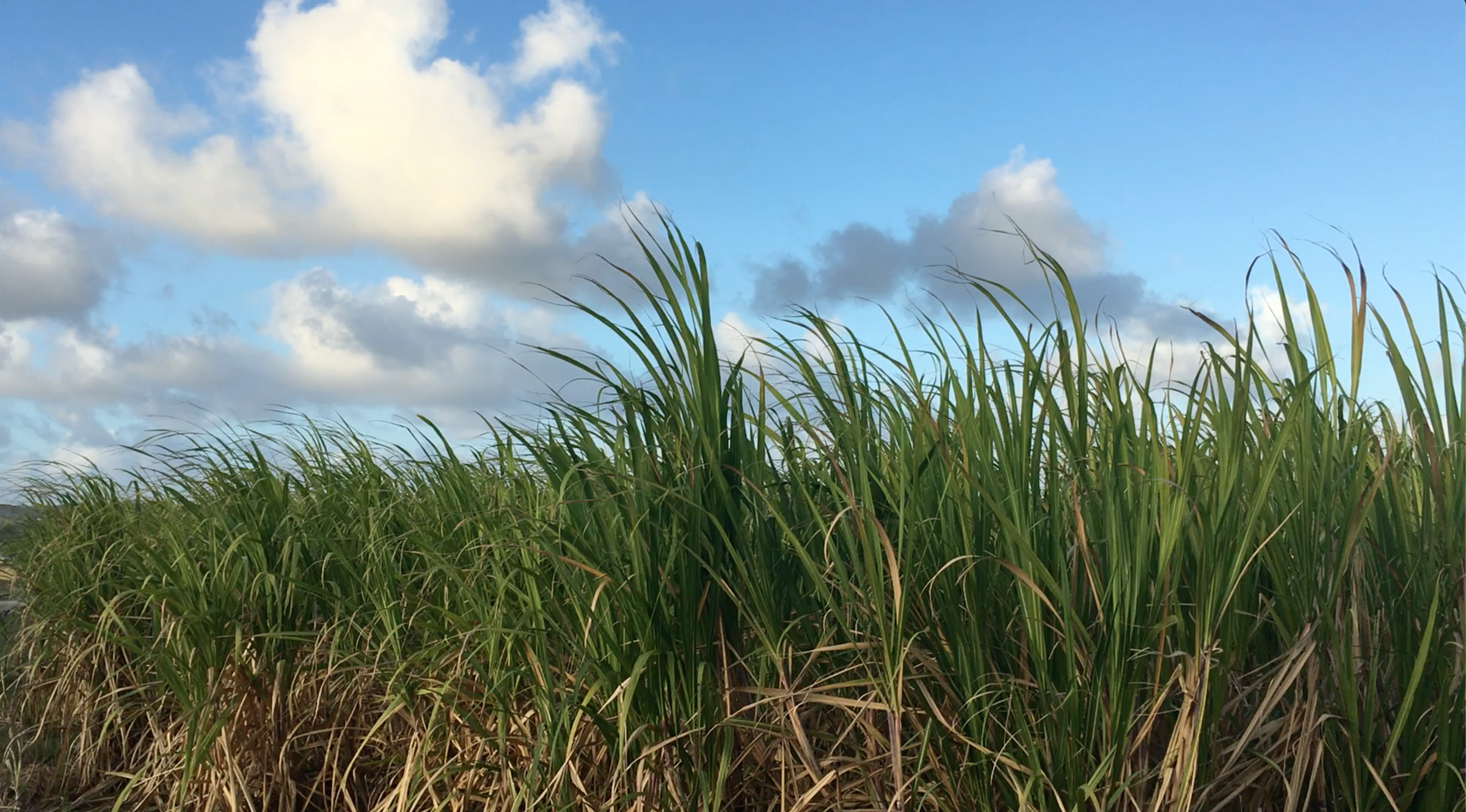
Are you finely aged?
Sorry, the content of this store can't be seen by a younger audience. Come back when you're older.
Rather watch & listen? Visit videos.
Why do we refer to rum as “light” and “dark”? We don’t talk about “Dark Whisky” or “Light Cognac.” “Dark,” “Gold” and “White” are food colors, not categories. So, let’s talk about How Rum is Made to be savvy sippers and informed about the value of what’s in our glass:
• Batch/Pot Still vs. Continuous Multi-Column
• Aged vs. Unaged
• Unmodified vs. Modified/Sweetened
The Real McCoy is a Small Batch Distilled, Aged, Unmodified Rum that is Single Blended – meaning a blend of distillates from two different stills on a single estate.
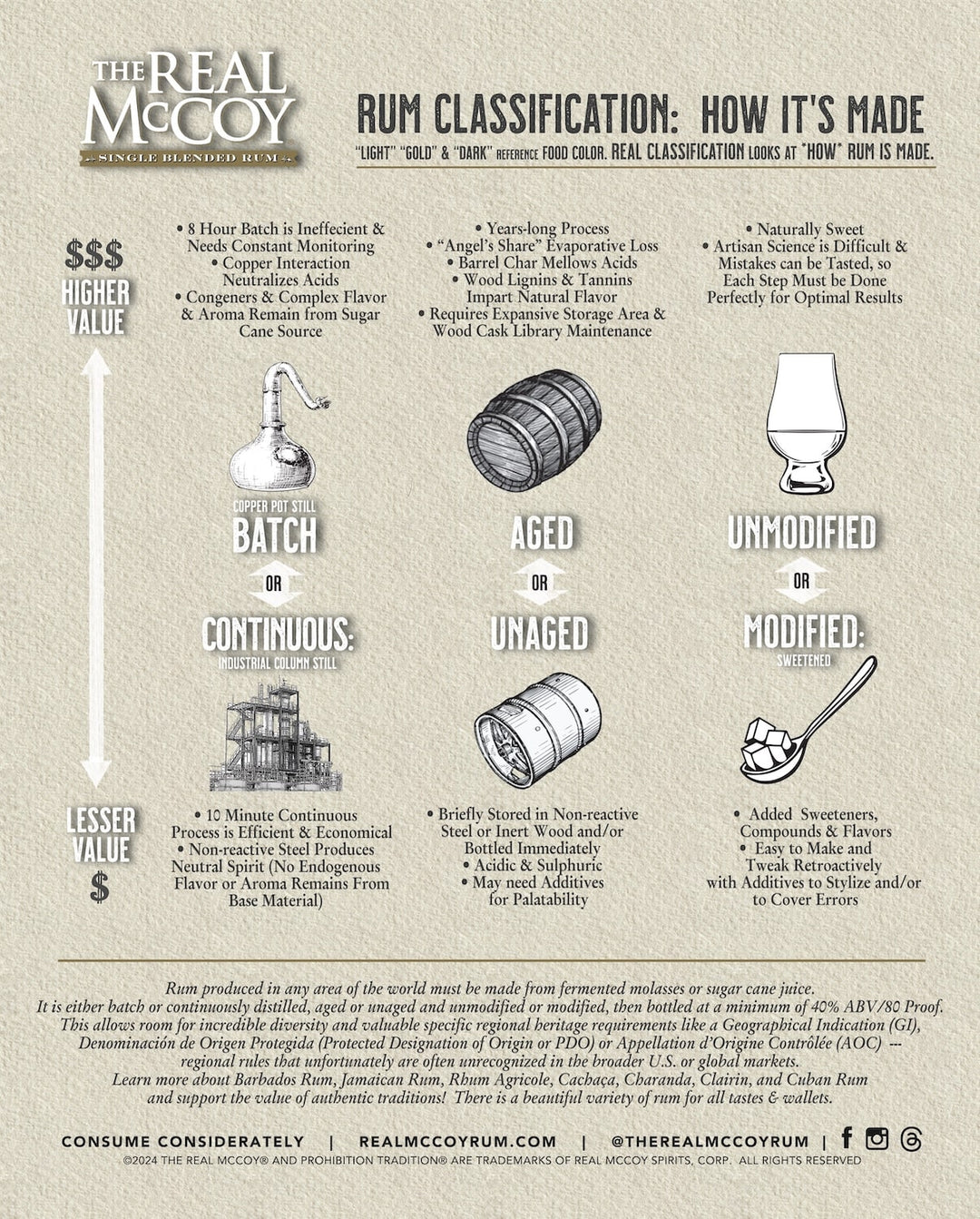
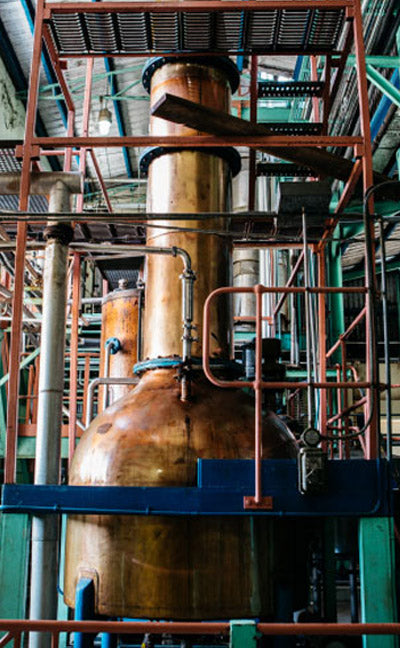
Batch distilling with a copper pot still takes about 8 hours for 1500 liters and requires constant scientific & artisan organoleptic monitoring – checking for volatile compound separations with a hydrometer and sensory review for flavor & aroma. The interaction of distillate with copper neutralizes the acids and sulphur, “softening” the spirit. The traditional copper pot still design is actually very inefficient – in a good way: it allows persistence of congeners – the unique character flavors we look for in rum.
Continuous distillation is high speed, large volume, inexpensive neutral (flavorless, odorless) alcohol production on an industrial scale. The “art” of distillation is greatly minimized by the continuous still in favor of efficiency, taking 10 minutes to distill what takes 8 hours in a pot still.
There are two types of continuous stills: copper and steel or aluminum. Copper is used to make rum, steel/aluminum is used to make fuel additives as they are more affordable metals, but do not “soften” spirit.
For batch distillation, look for the distillery name & location on label – often proudly on the front. Multi-column producers generally don’t discuss their methods on the label, so will not include a specific distillery name, but instead cite a location for production and/or “finish and bottling” per mandate.
Aged rum is placed in wooden barrels – often ex-bourbon white oak – for anywhere from several months to 15+ years as should be shown in an age statement. Per the U.S. TTB, the only legal age statement must read “Aged ____ Years” or “____ Years Old” and must refer to the youngest age in the blend.
Aging requires investing in & maintaining a wood cask “library”, lots of extra real estate and, well, time – obviously. It also causes evaporative loss or “Angel’s Share” of anywhere from 1-8% annually, with the highest loss in tropical climates. All of which adds up to extra cost, but, in return, properly aged spirits benefit from extracted wood lignins & tannins for amazing flavor profile and added value for the sipper.
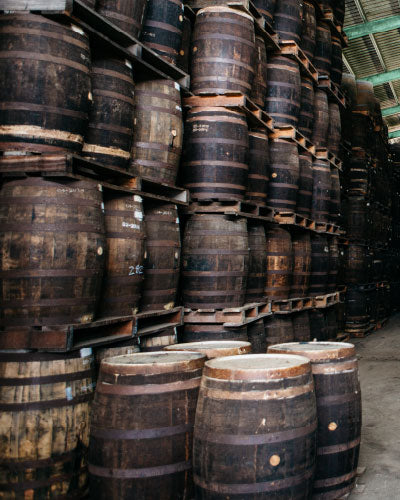
Unaged rum is bottled shortly after distillation. Non-reactive steel tanks or large inert wood vats (with massive staves too thick for interaction) are used for storage with no wood extraction occurring. Unaged style is sometimes found in French Rhum Agricole, Brazilian cachaça and is also common in high-volume industrial rum. Skipping the aging step can help maintain a fresh “grassy” flavor profile from cane juice distillates and/or get product to market very quickly, generally creating a more economical option for all.
Authentically aged rum will display a TTB-approved age statement and/or simple, clear year & bottling information. Read between the lines: marketing information can use arbitrary numerals and terminology like “solera” or “anniversary” and/or descriptors like “slowly” or “perfectly” instead of a fully transparent age statement to try to mislead the consumer.
AGED SPIRITS & THE REAL MCCOY
• Añejo “Sipping Tequila” is aged up to 3 Years. The youngest ‘Real McCoy, our 3 Year, is older than any añejo.
• Bourbon has no aging time requirements, but must be barreled in new oak. “Straight Bourbon” must be aged a minimum of 2 years, and “Bottled in Bond” must be aged at least 4. The ‘McCoy 5 Year is older than most bourbons.
• Scotch & Irish Whisky must be (made and) aged in their respective countries, where the Angels are generous and take only about 1% annual evaporative loss. In Barbados, The Real McCoy 12 Year experiences up to 63+% product loss – a whisky would need up to 60+ years for the same amount of loss and equivalent barrel interaction.
• Rum 90% of commercially-sold rum is industrial continuous column distilled and unaged with sweeteners, flavors & mouthfeel agents added. So, many people have never had the opportunity to taste a real rum! The difference is like comparing flavored moonshine products vs authentic aged Scotch whisky: some days we (or our wallet) might be in the mood for one or the other, but we like to be informed of the difference to understand the value. ;)
Unmodified rum has no additives, or, sometimes, minimal natural spirit caramel color. Naturally bitter E150a spirit caramel may be added solely to restore the natural color from the cask lost through dilution to bottling strength (~10 drops per gallon of water.) The practice is common in traditional rum and whiske/y, with the Scotch Whisky Act of 2009 allowing E150a by definition, and the TTB allowing up to 2.5% in some American whiskies.
There is a real art & science (and cost!!) to creating consistent unmodified spirits: Each step, from base product selection to fermentation to distillation has to be carefully & expertly navigated as every decision will affect the final outcome.
MODIFIED or Sweetened rum may have natural and artificial sweeteners added, as well as flavorings, perfumes, artificial colors, “mouthfeel” additives and chemical stabilizers --- all designed to replicate the body and flavor profile of pot distilled, aged rum. Modifiers can be allergens and/or the reason for the dreaded hangover, but they can also make for more affordable spirit options: production is simplified & economized because any shortcuts or errors can be amended by modifiers in the final result.
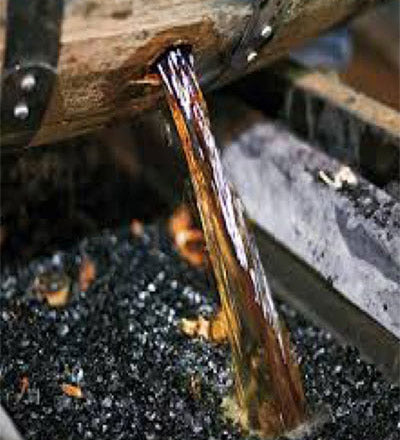
Place a few drops of spirit on your hand. Unmodified rum & spirits will simply evaporate – as alcohol quickly does - perhaps leaving behind a light aroma. Modified spirits leave a sticky residue and/or color that indicate sweetener and/or other additives.
Johnny Drejer at Drecon.dk developed an independently generated “List of Rums Measured” with a hydrometer & assessing density change caused by the addition of sweeteners which is shown in grams per liter. For reference, one of the highest modified rums shown contains 96 grams, which equals 23 teaspoons of sugar per liter.
BUT WHAT ABOUT “LIGHT, GOLD, DARK, BLACK & SPICED” RUM?
These terms all refer to modification -- most often of industrial column still distillate – not how real rum is produced. Color, sweetener, flavor and “mouthfeel” additives are meant to imitate valuable pot distilled and/or aged rum.
For example: the vast majority of light colored rum is unaged. The Real McCoy 3 Year and only a handful of other brands’ expressions are aged and then filtered to remove barrel color. This allows for more complexity in the flavor profile than an unaged spirit while retaining the light color that many bartenders & consumers prefer for cocktails.
By contrast, “black” and opaque rums are heavily modified with coloring. Actual aged rum cannot get any darker in color than the amber hue of ‘McCoy Distiller’s Proof or 12 Year. Distillate reaches a natural amber saturation point in the barrel and will not darken any further.
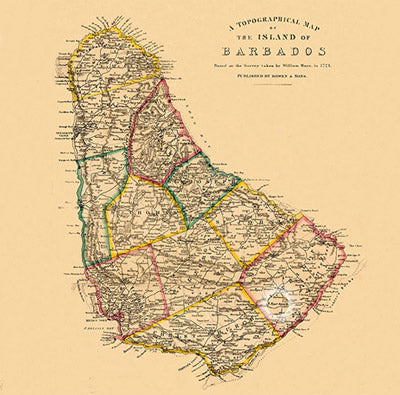
Rum is NOT the “Wild West”! Yep, there actually are rules. Plenty of them
Rum produced in any area of the world must be made in accordance with the rules of the producer nation. Regardless of area, rum must be made from fermented sugar cane molasses, juice or syrup and be bottled at a minimum of 40% ABV. (Distillates made from sugarbeets & sorghum may not be labeled rum)
The different national rules allow room for incredible diversity and valuable regional heritage requirements – rules that are often unfortunately not enforced in the broader U.S. and global markets.
Explore label designations from around the world - there is a beautiful variety of rum for all tastes & wallets. Some examples include:
Rhum Agricole – Produced in strict accordance with the Appellation d’Origine Contrôlée (AOC) in Martinique from cane grown only in approved territories. The fresh pressed cane juice may not be hot extracted, nor have any additives and must have minimum sugar content of 14º Bx and a minimum 4.7pH. Fermentation must be open top and under 72 hours. Distillation must be column with specific parameters. The final spirit is unmodified and may be aged for 3 months (“blanc”), at least 12 months (élevé sous bois) or at least 3 years (“vieux”) to meet separate specific designations. (Source: rhum-agricole.net).
Barbados Rum – Molasses, fresh juice or syrup may be used, and distillation & fermentation type is unrestricted, although non saccharomyces yeast strains must be native. Barbados water must be used to bring to bottling strength and all aging must be entirely on-island with the final product unmodified by sweeteners or flavors in the long-standing tradition of the “Birthplace of Rum.” Similar to whisky heritage, natural spirit caramel color is allowed. The majority of the island’s producers agree the longstanding parameters leave ample room for innovation and should become the pending Barbados Geographical Indication (GI.)
Cachaça – Can only be made in Brazil from fresh cane juice, with pot or column stills, must have a final congener count of 200-650mg/100ml, and can be unaged (most common) or aged (at least 50% must be aged 12 months.) Added sugar is allowed, but not spices or herbs. Only natural spirit caramel may be used for color.
Charanda – Made in Mexico from sugar cane juice & may be barrel aged in accordance with the 2003 Denominación de Origen Protegida (Protected Designation of Origin or PDO.) Charanda is an ingredient often found in “Mixto” tequilas.
Clairin – Rum Agricole’s close cousin produced only in Haiti with its own set of rules: Sugar cane must be hand harvested organic, wild or polyculture sugar cane indigenous to Haiti and transported to the distillery by animals. Cane juice may not be diluted or modified with water or chemicals. Fermentation must be natural and last a minimum of 120 hours, followed by distillation in pot or small batch column still. Bottling must be at still proof and done in Haiti. (Source: Maison Velier)
Cuban Rum – Molasses-based and column-distilled, rum according to Cuba’s PDO has many requirements, including one example from section 21.6.4:”...it is required to age all pure spirits for a period of at least two years in white oak barrels of 180-200 liters of capacity, generally of Irish or Scottish origin, which have already aged a spirit [i.e. whisky] in order to be labeled “Cuban Rum.”
Jamaican Rum – Fermentation and distillation must happen in specific regions above the limestone Aquifer water basins. The rum may be unaged or aged in oak and is unmodified -- “nothing shall be added to any spirits in a distillery save colouring matter or water” in accordance with the tradition that has recently been formally recognized under the Jamaican GI.
Many global regions also produce & sell delightful rum or spirits that do not fall within the traditional, GI, PDO or AOC practices. They simply are labeled “Rum” or “Liqueur” (<40% ABV) or descriptive names as appropriate, instead of “Jamaican Rum,” “Barbados Rum” or “Cachaça” etc., because there is inherent value to the traditions that the special moniker requires.
Keeping it simple, there are up to just 3 ingredients: water, rum, and sometimes natural caramel color. Oh, and *time* - arguably the most important of all.
BARBADOS SPRING WATER - Most distillates use “reducing water” to bring it to a quaffable proof. 80 Proof is 40% ABV or Alcohol by Volume which means 40% distillate and 60% water. So, the water is verrry important. Over 85% of Barbados is coral limestone which naturally filters the island’s water, producing unrivaled quality that is key to a fine Barbados Rum!
BARBADOS RUM - ’Real McCoy starts with 44 hours of molasses fermentation in closed-top tanks. This allows for product consistency and captures CO2 for re-use in soda carbonation on the island - preventing greenhouse gas emissions. The resulting molasses “wine” is then batch distilled in our 1750 liter copper pot still in a process that requires about 8 hours and careful, constant monitoring, as well as a twin-column Coffey still (named for Aenaes Coffey’s 1830 patent.) The distillate from both stills is blended before aging.
BARBADOS ISLAND TIME - The invisible ingredient. All of our expressions are tropically barrel aged onsite for a full 3, 5 or 12 years. The Barbados weather forecast calls for ~85°F/29ºC year ‘round, resulting in a 6-8% annual evaporative loss or “Angel’s Share.” By contrast, Scotland has 1-2% loss, and Kentucky or continental Europe, 2-4%. The higher loss in Barbados is worth it: the greater interaction of the distillate with the wooden barrel over time allows for greater extraction of lignins & tannins – enhancing flavor & mouthfeel of the rum.
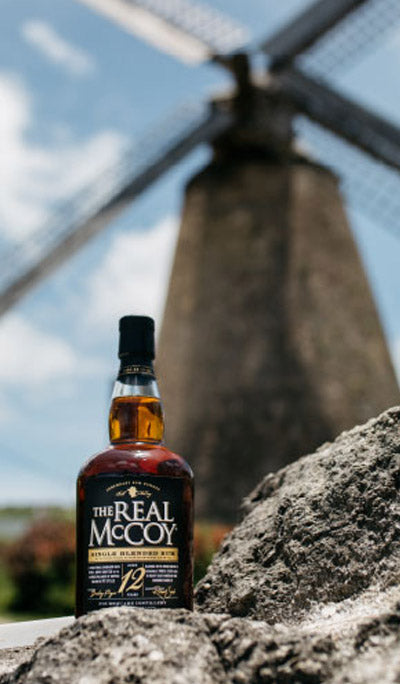
WHY DO INGREDIENTS MATTER? – Turning flush from that cocktail? Waking up at 3am? Or just not living our best life the next day? Additives & sweeteners can be mild to severe allergens and/or contribute – a lot - to hangovers.
NONE OF THAT, THANKS! – The Real McCoy doesn't add:
Sugar, High Fructose Corn Syrup or Sweeteners of any kind
Propylene Glycol, Sulfates or Animal-based Clarifiers or Ingredients, like Albumen, Casein, or Isinglass
Also NO:
Artificial Food Coloring
Artificial Flavors, ex. Vanillin, Maltol
Calcium Disodium EDTA
Carrageenan
Chemical Stabilizers
Citric Acid
Glycerol/ Glycerol Ester of Wood Rosin
Glyceryl Monostearate
Suspension Agents
Monosodium Glutamate
Pepsin
Polysaccharides
And, yep, those are all allowable ingredients in the beverage alcohol industry. In fact, it is the sweeteners & additives that may be allergens and/or cause that hangover. Go figure. Actually, we *do* have to go figure and guess what’s in our glass, because beverage alcohol ingredients are not required to be disclosed on labels. We think that should change.
The Real McCoy® = Real Barbados Rum = Just Rum
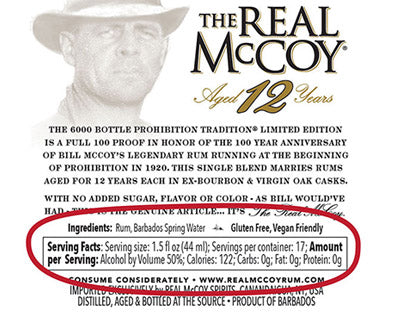
Consumer demand creates change, and we’re all consumers. (Well, 21+ or legal in your country of consumption, obvi.) We’re proud to say we worked for years to be the FIRST alcohol brand in the U.S. to independently verify & voluntarily list both Ingredients and Serving Facts on government (TTB) approved labels in accordance with FDA regulations in 2020. It’s a milestone and precedent that opens the door to further transparency in the industry. Please feel free to reach out to us with any questions and support GI respect and transparency in beverage alcohol legislation!
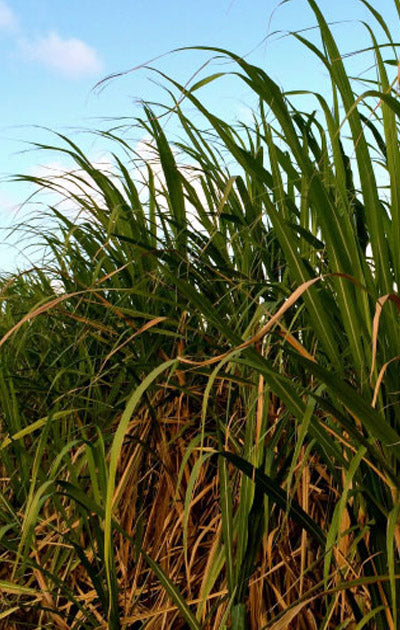
The Real McCoy Rum is produced at Foursquare Distillery by Master Distiller Richard Seale, who upholds the 400 year traditional practices found in Barbados.
SUGAR CANE TO MOLASSES – Sugar cane is harvested in batches limited to the quantity that can be processed in one day, while still fresh. Like any other produce, it begins to spoil once cut – especially in hot tropical weather – and the best flavor results come from fresh, unspoiled cane juice.
The cane then enters the sugar manufacturing process, of which molasses is a purposeful byproduct. All the molasses used for ‘Real McCoy comes from Barbados or nearby Guyana and is derived from the 3rd evaporation process during sugar manufacturing.
FERMENTATION – The Fermentation process involves three components: water, yeast and molasses. Naturally limestone-filtered water and the molasses are placed into closed top fermenter tanks which are temperature- and pressure-controlled. A specific yeast strain – saccharomyces cervicea – is pitched into the molasses solution and allowed to ferment for 44 hours until the molasses mixture achieves a 9-10% alcohol “wine.”
The carbon dioxide (CO2) resulting from the fermentation is captured and sent to our bottling plant for use in soda carbonation – avoiding releasing CO2 emissions into the atmosphere.
DISTILLATION – After proper fermentation, the molasses wine is transferred into one of two stills:
1750 Liter Copper Pot Still with Double Retort each batch requires 8 hours of distillation, sending alcohol vapor through 8 plates in the still’s helmet, and refluxing through 2 retort systems containing the “low wines” and “high wines” from previous batches. No defligmator or catalytic converter is necessary. The pot still yelds a “heavy,” flavorful, complex, and aromatic ~70% ABV spirit in a single batch.
Or
Coffey Still - Named for Aeneas Coffey who patented his more efficient whisky column still in 1830, this is a continuous feed 2-column copper still with 48 plates. It yields a 94% ABV spirit with clean, light flavor characteristics.
BLENDING – After adding Barbados spring water to reduce it to 63.5% ABV, “heavy” pot still rum is blended with “light” Coffey still rum in various proprietary percentages and placed in oak barrels for maturation (aging). We track our barrels in storage by either “Heavy Blend” - meaning greater volumes of pot distillate - or “Light Blend” - more Coffey still distillate.
Most of our rum is aged in 200-liter American Oak (Quercus Alba) ex-bourbon barrels for 3, 5 or 12 full years. For our Limited Edition series, we may vary the aging period and/or use other casks, including madeira, port, sherry, zinfandel and virgin oak wood.
Authentic tropical aging on the island causes a 6 - 8% annual evaporative loss, or “Angel’s Share.” So, as much as 63% is gone from the barrel by the time our 12 year is matured, requiring the “topping up” of barrels with other barrels of the same age. The 84ºF/28C year-round heat causes an important and delicious interaction of the distillate with the lignings & tannins in the wooden barrels for the most sippable results.
By contrast, in Scotland, France & Kentucky, the rate is just 1-4% yearly. It would take up to 60+ years in Scotland to have product loss & wood extraction equivalent to ‘McCoy 12 Year. We’re happy to tithe the Barbados Angels, though — it’s well worth it.
Aging Fun Facts:
• ‘McCoy 3 Year is older than any añejo “sipping tequila”.
• 'McCoy 5 Year is older than most bourbons.
• The Real McCoy 12 Year may have as little as a precious 36% left in the barrel.
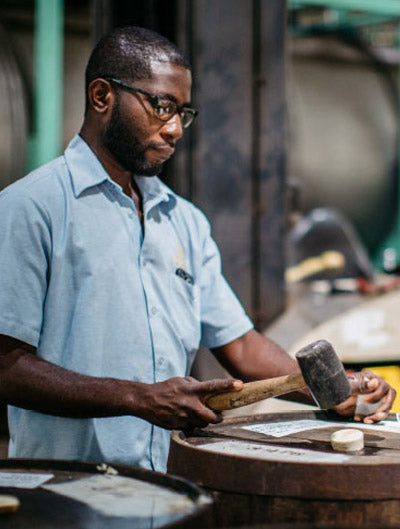
The aged rum is extracted from the barrels and transferred to our bottling plant at the distillery where it is blended with Barbados spring water in small tanks (about 50 cases worth each.)
“Single Blended Rum” – The Real McCoy is a single estate blend of distillates from two different still types.
BARBADOS G.I. – The last family-owned distillery on Barbados, Foursquare and our Master Distiller, Richard Seale, are passionate about authentic Barbados rum heritage, and are working with the majority of the country’s other producers, including Mount Gay and St. Nicholas Abbey to preserve their rum-making tradition with a Barbados GI (Geographic Indication).
The Real McCoy and all Foursquare rum products are made in accordance with the 400-year Barbados tradition of distillation, aging and bottling entirely on island with Barbados water and no added sweeteners or flavorings to be properly & proudly labeled “Barbados Rum.”
We support innovation in rum making and also believe it is important to specifically identify what may or may not be labeled with the valuable, hard-earned moniker “Barbados Rum.”